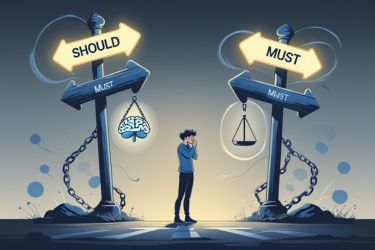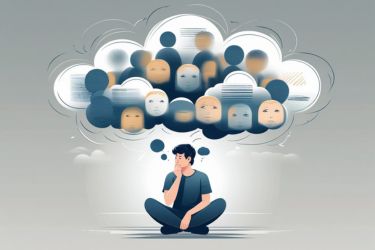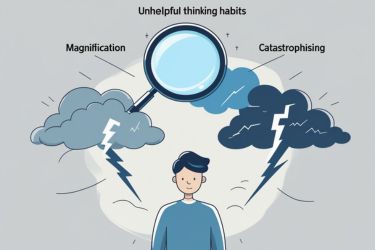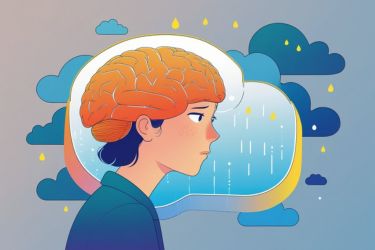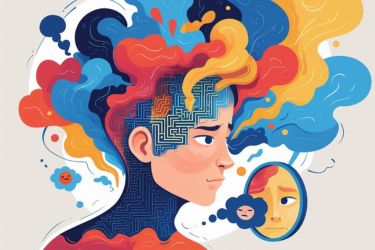Labelling is a common unhelpful thinking habit that many of us fall into without even realising it. This habit can limit our self-view and affect our relationships by reducing complex individuals to simple, negative labels. When we label ourselves or others, we often ignore the full range of traits and behaviours that define a person. This can lead to negative thought patterns that impact our mental health and well-being.

Understanding labelling as a cognitive process allows us to see how it shapes our perception. We may label ourselves as "useless" after a mistake or view others as "idiots" based on a single action. These thoughts can become automatic, influencing how we interact with ourselves and those around us. Recognising these patterns is the first step towards breaking free from them and fostering a healthier mindset.
In this blog post, we will explore the impact of labelling, its consequences on our mental health, and strategies to challenge these thoughts. By addressing this unhelpful thinking habit, we can create a more positive and nuanced understanding of ourselves and others.
Key Takeaways
- Labelling reduces individuals to simple, negative descriptions.
- This thinking habit can have significant consequences for our mental health.
- We can adopt therapeutic approaches to challenge and change labelling patterns.
What Is Labelling as an Unhelpful Thinking Habit?

Labelling is a cognitive distortion where we assign broad labels to ourselves or others based on specific behaviours. This mindset can negatively impact our self-esteem and relationships. Understanding its origins and examples helps us recognise this thinking pattern in our daily lives.
Definition and Origins
Labelling involves making an absolute statement about ourselves or others based on a single action or trait. For example, we might think, "I failed that test; I am a failure." This reflects a global negative rating rather than recognising that failure is a part of learning.
The term comes from cognitive therapy, influenced by Aaron Beck's work. He emphasised how automatic thoughts can lead to cognitive distortions. Labelling is one of these distortions, where we generalise behaviours to define our worth.
How Labelling Differs from Other Cognitive Distortions
Labelling is distinct from other cognitive distortions like all-or-nothing thinking. While all-or-nothing thinking views situations in black and white, labelling simplifies people to single traits.
For instance, if someone struggles with communication, we might label them as "shy," ignoring their positive traits. This habit also connects to overgeneralisation, where we make sweeping statements based on limited evidence. Unlike many cognitive distortions, labelling can lead to a fixed mindset, stifling personal growth and change.
Examples of Labelling in Everyday Life
We encounter labelling frequently in our daily interactions. For example, if we mistakenly spill coffee, we might label ourselves as "clumsy." This label does not consider the many times we handle tasks well.
In social situations, we may label others, thinking, "He's always rude," after one unfriendly encounter. This limits our ability to see them as complex individuals.
Additionally, labelling can occur within families or workplaces, where certain members may be tagged with negative labels, affecting their confidence and behaviour. Recognising these instances enables us to challenge these unhelpful thinking habits and promote a more understanding perspective.
Cognitive Processes Behind Labelling

In understanding labelling, we must explore the cognitive processes that contribute to this unhelpful thinking habit. Two key concepts are negative automatic thoughts and emotional reasoning. Both affect how we perceive ourselves and others, leading to distorted thinking patterns.
The Role of Negative Automatic Thoughts
Negative automatic thoughts are spontaneous and often negative ideas that pop into our heads without conscious control. These thoughts can quickly lead us to label ourselves or others based on a single experience.
For example, if we fail at a task, we might think, “I always mess things up.” This thought not only represents a negative view of our abilities but also sets a standard for how we view ourselves moving forward.
These thoughts create a cycle of negative thinking. The more we engage in labelling, the more likely we are to reinforce these cognitive distortions. Recognising these automatic thoughts is essential in cognitive behavioural therapy (CBT), where we learn to challenge and replace them with balanced thinking.
Labelling and Emotional Reasoning
Labelling is closely linked to emotional reasoning. This occurs when we allow our emotions to dictate our thoughts and beliefs about ourselves or others.
When we feel sad or anxious, we might label ourselves as "failures" or "unlovable." This way of thinking leaves little room for objective assessment. We believe our feelings reflect reality rather than recognising they are temporary states.
This process can amplify negative emotions and lead to a distorted image of ourselves or others. Understanding how emotional reasoning interacts with labelling can help us avoid making snap judgments based on fleeting feelings. Through practice, we can learn to see beyond our immediate emotions and recognise the deeper truths.
Related Unhelpful Thinking Styles

We often encounter various unhelpful thinking styles that can distort our perception of reality. Understanding these related styles helps us recognise patterns in our thoughts that may lead to negative feelings and behaviours.
Black-and-White Thinking and All-or-Nothing Thinking
Black-and-white thinking, also known as all-or-nothing thinking, is a common cognitive distortion. In this style, we tend to see situations in extreme categories. For example, we might believe we are either successful or total failures, with no middle ground.
This kind of thinking can make us feel hopeless when we do not meet our high standards. Often, we might set unrealistic goals and then feel disappointed in ourselves when we fall short. Recognising this pattern is crucial for adopting a more balanced view.
Overgeneralisation and Fortune Telling
Overgeneralisation occurs when we take one negative experience and assume it applies to all similar situations. For instance, if we fail at a task, we might think we will always fail. This habit reinforces feelings of inadequacy.
Fortune telling is another negative thought pattern where we predict negative outcomes without any evidence. We might think, “I will definitely make a mistake,” which causes anxiety. Both thinking styles can create a cycle of fear and self-doubt, affecting our mental health.
Personalisation, Blaming, and Mind Reading
Personalisation involves taking responsibility for events beyond our control. For example, we might think we caused a friend’s bad mood. This leads to feelings of guilt and blame, even when it isn’t warranted.
Blaming is the opposite, where we attribute our problems to others. This can prevent us from addressing our own growth. Mind reading involves assuming we know what others think about us or our actions, often leading to unnecessary stress.
Each of these styles reinforces negative thought patterns that can limit our emotional well-being. By identifying them, we can challenge these thoughts and seek healthier ways of thinking.
Consequences of Labelling on Mental Health

Labelling can have significant effects on our mental health. It shapes how we see ourselves and interacts with our feelings, impacting everything from self-esteem to levels of anxiety and stress. Understanding these consequences is crucial for improving our mental wellbeing.
Impact on Self-Esteem and Frustration
When we label ourselves or others, we often create a fixed view that does not consider the full person. This can lead to low self-esteem, as individuals may internalise negative labels. For instance, being called "lazy" can foster feelings of frustration and inadequacy.
People may start to believe that they are defined by these labels rather than seeing their abilities and potential. This mindset can lead to a cycle of negative self-talk and diminished motivation. When frustrated with ourselves, we may avoid challenges, which further weakens our self-worth.
Labelling, Anxiety, and Depression
Labels can increase feelings of anxiety and depression. When we identify someone solely as "anxious" or "depressed", it can overshadow their other qualities. This reduces their sense of identity and makes them feel trapped in their condition.
Moreover, diagnostic labels can lead to a heightened focus on one’s flaws, causing us to expect constant struggle. This mindset can amplify anxiety, as we may feel pressured to conform to what the label suggests. The link between labels and mental illness is complex and can create larger barriers to recovery.
Relationship with Stress and Negative Emotions
Labelling also influences our relationship with stress and negative emotions. Those who are labelled may experience increased stress as they try to live up to external expectations. These labels can create a fear of failure, leading to performance anxiety and avoidance of situations that might cause stress.
Negative emotions often stem from persistent labelling. We may feel anger, sadness, or frustration towards ourselves and others. This emotional turmoil can lead to unhealthy coping mechanisms, affecting our mental health. It’s essential to recognise these patterns to break the cycle and foster a more positive mindset.
Therapeutic Approaches to Address Labelling
We can effectively tackle unhelpful labelling through various therapeutic approaches. These methods, particularly Cognitive Behavioural Therapy (CBT), help us recognise negative patterns and replace them with healthier thoughts.
Cognitive Behavioural Therapy (CBT) Strategies
Cognitive Behavioural Therapy is a powerful tool in addressing labelling. It helps us identify the automatic thoughts that lead to labelling ourselves or others.
In CBT, we can work through the following steps:
- Identify Triggers: What situations lead us to label ourselves?
- Challenge Thoughts: Are these labels accurate or helpful?
- Replace Labels: Shift our language to more positive and realistic statements.
An example could be changing “I always fail” to “I sometimes struggle, but I learn and improve.” This shift reduces the harmful impact of labelling.
Recognising and Changing Unhelpful Thinking Patterns
Recognising our thinking patterns is crucial. We often use labelling as a defence mechanism or to simplify complex situations.
To change these patterns, we can:
- Keep a Thought Journal: Write down moments we label ourselves. This helps us spot patterns.
- Practice Mindfulness: Being present allows us to observe our thoughts without judgment.
- Use Positive Affirmations: Regularly affirming our worth can counteract negative labels.
By doing this, we create new habits and cultivate a more positive self-image. Together, these strategies empower us to break the cycle of unhelpful labelling.
Frequently Asked Questions
In this section, we will explore key questions about unhelpful thinking habits, specifically focusing on labelling. We will look at examples, impacts on mental health, strategies to challenge these habits, and the ways labelling contributes to cognitive distortions.
What are common examples of labelling in cognitive behavioural therapy?
Common examples of labelling include terms like "failure" or "loser" after making a mistake. We often judge ourselves based on single events instead of seeing the broader context. This can lead to a fixed mindset that does not allow for personal growth.
How does negative labelling impact mental health?
Negative labelling can lead to feelings of worthlessness and anxiety. When we label ourselves harshly, it can affect our self-esteem and self-image. Over time, this pattern may contribute to depression and other mental health issues.
What strategies can be employed to challenge unhelpful labelling?
To challenge unhelpful labelling, we can use techniques such as reframing our thoughts. We might replace negative labels with more neutral or positive descriptions. Keeping a journal of our thoughts can also help us identify when we label ourselves unfairly.
In what ways do unhelpful thinking habits contribute to cognitive distortions?
Unhelpful thinking habits create cognitive distortions by skewing our perception of reality. For instance, labelling ourselves negatively can lead to black-and-white thinking, where we see ourselves as entirely good or bad. This makes it hard to recognise our complexities as individuals.
How can one identify and alter labelling thinking styles?
Identifying labelling thinking styles starts with awareness. We can pay attention to our self-talk and notice when we use negative labels. Once we recognise these patterns, we can consciously work to replace them with more balanced perspectives.
What are the psychological effects of persistent negative self-labelling?
Persistent negative self-labelling can lead to chronic feelings of inadequacy and low self-worth. This can hinder our ability to form healthy relationships and achieve our goals. Over time, it may also contribute to more severe mental health conditions, making it essential to address these thoughts early.


